Home Movie Facts Fans+Reviews Where to Watch News+Blog Store

Do you enjoy foraging? I do. So do other members of The Emissary cast. In my novelization of the movie, it seemed fitting to cast our hero from outer space as a plant collector, too.
Peter Ciesla dyeing fabric with goldenrod at Bazyli Studio
Koyper bent to examine the jewelweed energetically pushing up between the round, grey rocks jumbled along the edge of the shore. He plucked at the leaves, and swiftly removed one of several small metal tubes from his backpack to add the specimen to his collection.
The Emissary, © 2017 Holly Phaneuf Erskine. All Rights Reserved.
Foraging is more than a diversion for me. Part of my passion for all things biological stems from my conviction that our learning the code of nature's
sophisticated technology is, on a broader scale, a matter of life and death for the human race.
I'll explain why in a bit.
First, foraging gives daily, simple, joyful moments of appreciation for the cultural lore of our ancient, living world. When I learn about a new plant, the first thing I do is type its Latin name into the National Library of Medicine's Pubmed to see what research has been done on it, and hopefully I can get a list of its constituents. Some plants have thousands of studies. Some have only a handful. Most plants have some research on them. I think some folks might be surprised to know that.
Then, to round out my knowledge, I like to see what folklore might exist surrounding my new interest. Some of the folklore is on to something. And some of it requires historical interpretation. For example, anything claiming to "purify the blood" sounds nice, until you learn that "purifying the blood" is a polite archaic euphemism for curing venereal disease. Which probably didn't work.
Because I have built up relationships with so many plants, when I travel in strange places, I still find familiar green faces. In the most urbanized
cities I can still greet a familiar old friend like plantain cramming its way through sidewalk cracks. (Plantago major provides the seeds
for commercial fiber supplements like Metamucil, plus its greens make a nutritious salad addition.) I have yet to visit any spot in America
where wild catnip doesn't flourish, and I am often bringing home a fresh sprig for my feline tribe to battle over. Foraging is good for our health
and the environment for many reasons. It is an ancient way of showing gratitude for what we are given.
In order to forage, you have to recognize the right species of plants or fungi so you don't kill yourself with the wrong ones. Which sometimes happens. No matter how much we laud the benefits of a plant-based diet, and we should, you don't see people roaming around on their hands and knees eating random weeds everywhere. Instinctively, you know the botanical and mycological oddballs are out there, which will give you cramps, make you vomit, and then you will possibly die. Hemlock, death's cap mushroom, and others. You have to know what you are doing. I use a microscope to ID my mushroom spores but I am a scaredy pants. It isn't necessary to be so rigorous with certain plants or mushrooms that don't have dangerous lookalikes. I just like an excuse to use my microscope.
Foraging can become an addictive form of treasure-hunting. If you relish the taste of garlicky ramps or meaty morels, you will be out
there with me in the early spring wandering the woods and fields. There are only a few weeks every spring when ramps and morels flourish.
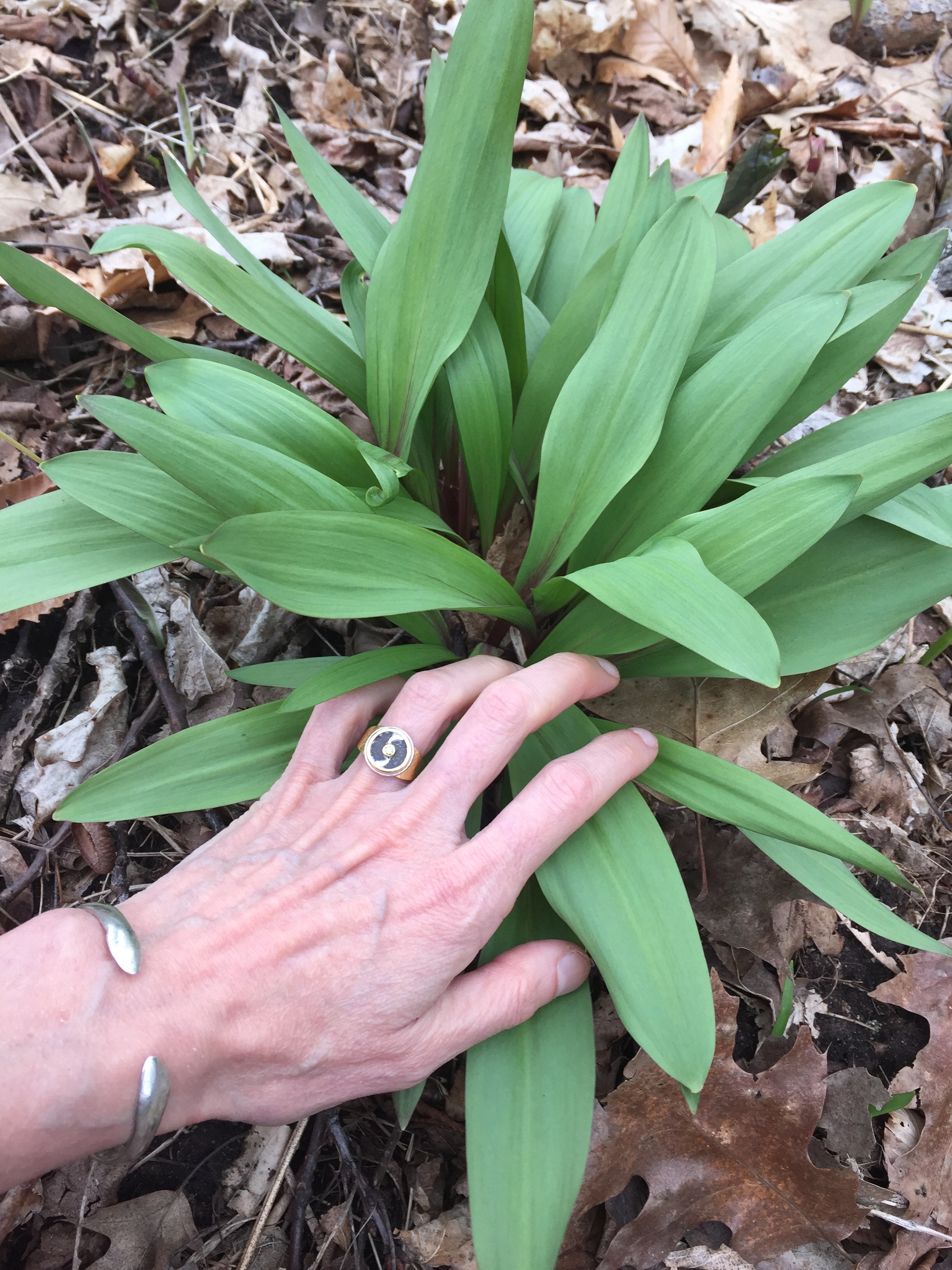
Every spring we transplant a few wild ramps (also called wild leeks) from the woods to our yard,
to keep them going strong.
Some people make money foraging. I never know when a particular top-secret oak in my neighborhood will explode with a carpet of the hard-to-find
and pricey black trumpet mushrooms. Once I knocked myself out gathering over twenty pounds of yellow chanterelles (in the pouring rain), worth around
twenty dollars a pound, from our local woods. I've met some locals who sell their bounty to restaurants that are grateful to feature lobster mushrooms
or ramps or morels on their seasonal menus. I just dry or freeze mine. Years later, we still have several bags of dried chanterelles in our pantry
which we can't be bothered to eat because we are tired of them.
Most of my efforts are more humble. I'll just pick some of our plentiful weeds. Dandelion, purslane, sow thistle, mallow, and lambsquarters
leaves get sautéed in olive oil to take some of the spirit out of those bitter sesquiterpenes. Delicious and nutritious! Beats going to the store.
Cheaper, too. Plus I don't use any weedkiller.
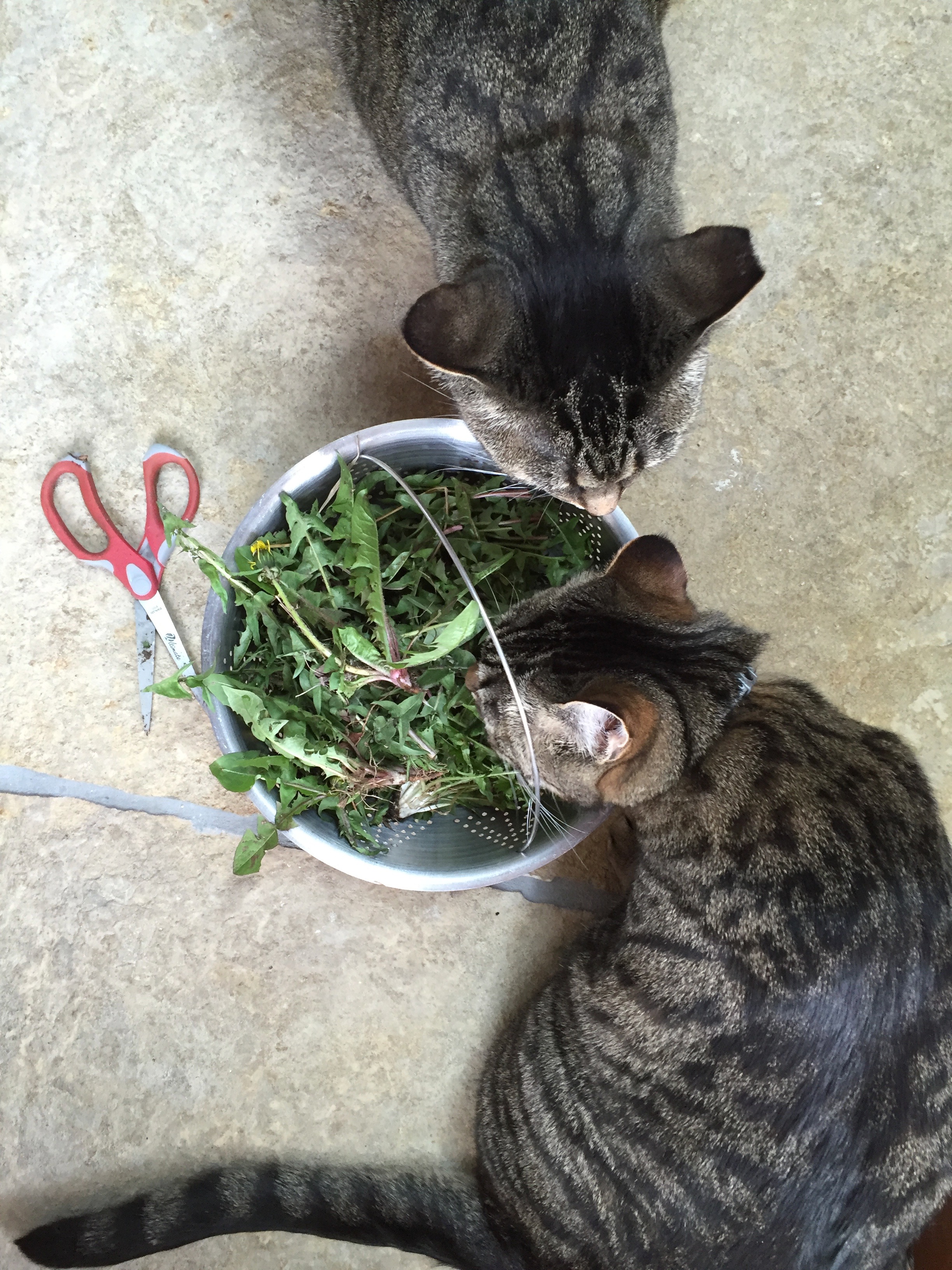
Neutron and Fringes check out my dandelion harvest. They prefer catnip.
Foraging can be a matter of survival. It was an activity required for our ancestor's survival and in some cultures still is. I would rather
not have to depend on foraging for survival, but in the back of my mind, there is the quiet whisper that says, At least I will know what plants and mushrooms are safe if there is some catastrophe.
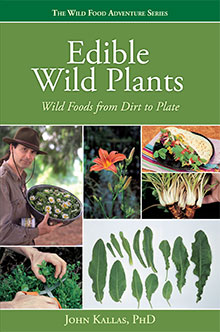
My favorite book on easy, safe foraging edible weeds
(with recipes!) is by Dr. John Kallas, Edible Wild Plants.
I have our spaceman collecting plant samples throughout the Emissary book. What put this idea in my mind? It first occurred to me in reviewing the the raw footage, or dailies. One particular scene came out better than we had anticipated.
There were just three of us. I was behind the camera, filming the director, my husband, Tim Erskine, as Door County resident Jim, and Peter Ciesla
as Koyper the Spaceman.
It had been a magical morning in Newport state park. Like diamond necklaces draped over a bed of jewels, the dew glittered on fresh spiderwebs laced across a field of vividly colored prairie flowers. Energetic insects, birds and mammals invigorated the field with all of their mysterious morning activities. We were knee-deep in Nature. We were explorers on another world, except that the world we had entered was ours. We were a bit giddy.
Bleary-eyed, sleep-deprived, and completely drained after long nights of filming into the wee morning hours for days on end, the sunshine and life refreshed
our souls. That one morning filming in Newport State park was utterly enchanting and I am sure we will never forget it.
In this scene, Koyper the spaceman is wandering around picking flowers and enthralled with simply being on Earth. He asks Jim, "Do you ever get used
to being under the sky?" His wonder for being on Earth seemed appropriate for a human who spent most of his time living far away on a space colony.
It is still one of our favorite scenes.
______
When Koyper finally spoke his voice sounded wistful. "Do you ever get used to being under the sky?"
Jim started, the realization hitting him at last. He's not looking for anything up there. He's just not used to being on a planet's surface, he thought. It must feel overwhelming."I
suppose you do." Jim grinned. Koyper's obvious delight over something as simple as looking at the sky was infecting him. "Unless you are trying to
pay attention. Which is just what we were trying to do when you landed, as a matter of fact."
Koyper shook his head. "I have been to Earth many times. But I just cannot get used to it. I just cannot." He beamed
at Jim. "It makes me feel so big on the inside! And I love it!" He straightened as if he were indeed struggling to take something large into himself.
Gazing down on the meadow once more, his grin broadened. "And all the little wild things everywhere!"
"Don't you have plants and animals on the Colony?"
"Well, we do. We actually have quite a lot of them. But it is like…big garden. You cannot fake the wilderness!"
While he exclaimed over the wilderness, a member of it in the form of a mosquito landed on his neck. Jim reflexively moved his hand to bat it away from the spaceman.
Koyper recoiled. "What are you doing?"
"A mosquito."
"I like to be stung by mosquitoes!"
"What?"
"Well, they really don't hurt me. And I never get to experience that on the Colony."
"I predict you'll grow tired of it."
The Emissary, © 2017 Holly Phaneuf Erskine. All Rights Reserved.
_____
What Emissary fans might not know about the actor who plays Koyper is that Peter Ciesla is an active and knowledgable forager. When Tim and I both missed our vaccinations and came down with the 2009 swine flu, I will never forget how Peter left on our doorstep a big jar of hearty vegetable soup containing burdock root, known in Asian cultures as gobo. He had harvested the roots on his Baileys Harbor residence. If anyone has ever tried harvesting burdock roots you know that's a labor of love. The roots grow deep and require extra strength to extract. It's not something I have ever had the strength to do, as much as I would like to eat gobo. I would need power tools I think. I still recall how delicious and nourishing that soup felt when we were laid low.
Peter is also an established fabric artist and designer who sometimes uses plants to dye his materials. You can see Peter and his creations at Bazyli studio in Door County,
Wisconsin. As a matter of fact, right now as I am writing, he's texting me about experimenting using goldenrod to dye cotton. Can't wait to see how
that comes out!

The day of posting this article Peter won an award for this!
Some of Peter Ciesla's handiwork: linen dyed with black walnut;
it is "a little bit of tie dye and a bit of shibori".
Original design, dyeing, and fabric art at Bazyli Studio in Door County Wisconsin.
I shared my own passion for foraging with Peter on the set. To pass the time, we spent many hours outdoors that would otherwise have been tedious, waiting for the scene to be set, discussing whatever weeds were visible to us. It was surprising how many of these Peter recalled from his childhood in Poland, that his grandmother had used in a soup! I gathered that his grandmother was a true old-world herbalist. How I would love to be able to probe her knowledge! I'd still like to record what Peter remembers of it.
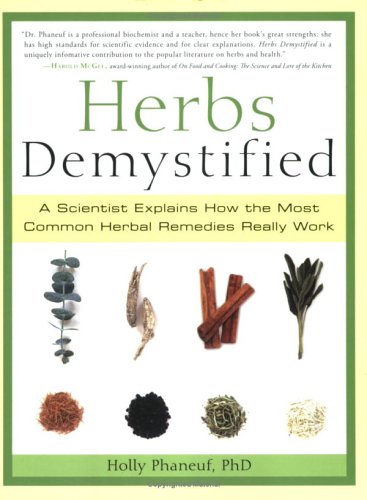
I wrote this.
Those of you who know me know that I have a lifelong passion for plants and their constituents, and some of you may even have my 2005 book, Herbs Demystified. which you can find online, or borrow a copy from the Door County library. (It's also available in Italian and Mandarin, although I haven't read those versions so I can't tell you what I think about them. I'm still working on learning English with the assistance of various patient editors.)
My interest in plants grew early in life. Perhaps I was an insecure child, because I felt it might be useful to learn about what plants I could use to survive. Just in case! I'm still insecure, just for other reasons.
And possibly from reading fantasy stories and viewing The Wizard of Oz as a tot, I became enamored with the notion that I could become a good witch and make magic potions to heal people. That sounded like a worthy goal. I quickly learned this wasn't socially acceptable or in any way profitable. I became a chemist instead. It is sort of the same, only with science. Less glamorous.
I grew up collecting foraging and plant books, got bachelors degrees in biology and chemistry, and melded my interest in botany with my eventual doctoral
degree in medicinal chemistry. Medicinal chemistry is something I still end up having to explain to doctors and pharmacists—ironic because
I used to teach both med students and pharmacy grads—it is the science of drug design and synthesis. Not many of colleges have a med chem graduate
program. Our lab in Salt Lake was mostly interested in antioxidants in the 90's, just when antioxidants were becoming all the rage. That's another
story, but it gives you a sense of my background.
____
"Oh look!" Koyper clasped his hands under his chin and stared down into the pond. His excitement was contagious.
"That's Past and Present. Under that rock there is Future." Jim pointed to each fish in turn.
Koyper sighed and sank into a deep squat beside the pond. The koi swam up to Koyper's outstretched hand, and he gently stroked the back of each with his index finger. They seemed eager to be petted by him.
They never do that for me, Andy thought. I wonder if they know he is from outer space. He caught himself. What do fish know about outer space? A deeper thought rose to the surface of his mind. Are we like fish?
"Each one is essential." Koyper smiled slyly up at them. "Excuse me? May I?" He removed one of his little shiny metal canisters from his backpack and shook it. "Algae." He nodded toward the pond. "I was wishing for Spirogyra in particular."
"Of course!" Jim's eyebrows shot up. "Have all you want. Please."
Koyper beamed up at him with intense gratitude, as if Jim's pond scum was the one piece in his entire life that had been incomplete, which finally had been granted to him at long last.
He rolled up one shirt sleeve. For the first time Andy saw a curious coppery bracelet around his wrist. It appeared to be covered with a curious marks that looked like a cross between Egyptian hieroglyphs and Asian characters.
They watched Koyper tenderly pinch a wad of slimy green strands from the pond with his thumb and forefinger. There was a certain confidence and quietness to his movements, as he inserted the goo into his tube. Andy could swear he heard a little sucking sound of air as the canister snapped closed. He's preserving it, he thought, and felt his stomach lurch. At least some of Door County will survive if the generator blows up.
The Emissary, © 2017 Holly Phaneuf Erskine. All Rights Reserved.
__
Most medicinal chemists work for drug companies or remain in academia. I stayed in academia, and I loved teaching, but sacrificed my tenure to move to Door County. Painful, yes, very, but the move forced me to try strange new tricks like filming and novel writing, and my nervous system thanks me every day for all the rare peace and quiet that I get living in this friendly rural area.
Medicinal chemists know that plants, fungi, and sometimes even animals (often their venoms) provide much of the framework for both old and new pharmaceuticals. You'd be hard pressed to find a pharmaceutical that does not have a natural analogue to inspire it. What is formally called natural products is a required part of medicinal chemistry coursework.
I give medicinal plant hikes for the Door County Land Trust, here at Three Springs Nature Preserve.
Some of my colleagues, poor things, went off to Fiji every year to scuba dive for the marine animals known as tunicates, as possible sources of new
anticancer therapeutics and antibiotics. Others interviewed Native American tribe elders on their use of medicinal plants, hoping to get clues on which
plants to bring back to their lab. The lab around across the hall from ours always had a flask the size of a small child stirring away all day, full
of leaves and solvent, working away to extract whatever was held in the leaves for later analysis.
I didn't do anything so glamorous, I just synthesized drugs that I hoped would make good general antitoxins. The labs in our department all did a variety of different things, but we were all aware how necessary it was to study what nature had already made, because nature is literally a few billion years ahead of us in developing drugs.
Each organism is a potential treasure house of technology and medicine, and I want that theme in my book to be loud and clear in my book.
Without being preachy.
____
"So…how exactly does your colony manage the limited resources out in space?" Jim knew he was edging onto territory that Koyper was cagey about. He braced for an evasive reply.
Koyper was silent for a moment before he spoke. "All organisms are limited. Think about cells. The smallest packets of life. Cells are limited by the nutrients they can take in and the wastes they must push out. Cells are just like tiny little highly efficient space colonies. That is why the Emissary must study them."
Jim studied Koyper's face for any trace of his characteristic teasing and decided that he was being serious for once.
"All cells recycle, for example." Koyper placed his palms together, continuing. "Every single one. From the most primitive bacterium to the most sophisticated neuron in your brain. A cell will die if it did not recycle. This teaches us. Cells must use resources efficiently. Cells never just spit out their old proteins for example. That would be so ungrateful."
Koyper smiled, warming to his topic. "No. They break down old proteins into amino acids and use those pieces again to assemble new proteins. The same with all their other parts. Cells would not have survived over three billion years on your planet if they had not learned to recycle their parts. The Emissary learns from nature what works. Life is the highest technology in the universe!"
Jim thought of Koyper's backpack full of living samples. Obviously Koyper treasured them. But were his little plant samples the really the most sophisticated technology in the universe?
"But…alien technology…it must be incredible…" Jim's hands reached out as he grasped for the right words.
Koyper pinched something off his plate and held it up. It was sprig of mint. "The highest technology that we know of in the universe is all around us. It is in life." He spoke slowly and emphatically, shaking his mint as he spoke. " This is high tech."
"High tech mint…" Andy mumbled tiredly from the recesses of the cushions of his recliner. He appeared to be dozing off. They ignored him.
"Okay…" Jim frowned. "So living cells teach the Emissary how to recycle."
"Cells have mastered it. And energy. And efficiency. And building materials. Cells have worked on it for billions of years and when they don't get it right they pay for it with extinction. Humans have only had hundred years or so of trying."
Jim tried to figure out why he felt disappointed. Surely he was missing something. "But your aliens…don't your aliens have some sort of special…" He couldn't think of the right words. He felt stupid. Aliens always had superior technology. Because they were aliens.
"We were just talking about the value of limitations," Koyper said. "The other side of limitations is not putting all of your eggs in one bucket. Nature teaches us over and over that diversity, complexity is required for survival. When you have only one species of plant, like the Irish and their potatoes, or one gut microbe, you get sick, there is starvation, there is imbalance. Multiple species keep each other in check in a healthy system. And this balance is always changing. Nature always changes. There are always new ways for the Emissary to do things. We must constantly learn how to survive." He stabbed at a sliver of mushroom on his plate and held it up with his fork. "Mushrooms and plants are different. They both make cell walls, but they have different styles. They use different materials. Both kinds are highly sophisticated, but for different reasons. And one plant makes energy differently from another plant."
He pointed to his feet excitedly. "This planet is a gigantic classroom for learning technology! Right here! All around you on your planet! Not up there," he pushed his mushroom-laden fork up at the ceiling for emphasis. "It's mostly dead up there in space." He swallowed his example and chewed it slowly.
Jim tried again. "But wait. There must be something up there that you've got that we don't down here."
Koyper became quiet and smiled knowingly at him with half-closed eyes. He appeared to be holding something back.
"When something is all around, you don't value it. It is not…exceptional. The Earth is space colony, just bigger than the Colony. You have quarter of million people born on Earth every single day. Even after your death rate. Two-hundred-and-fifty thousand new people are here every single day. The more common things are, the more you do not value them. Unfortunately. Life should never be too common. Life should be valued. It is the most precious thing in the universe. You will have to learn to stretch, too."
A chill spidered its way up Jim's neck. Somewhere in the dark shadows of his recliner a soft, sinusoidal buzzing indicated Andy had succeeded in drifting off.
The Emissary, © 2017 Holly Phaneuf Erskine. All Rights Reserved.
_____
Plants make primary metabolites and secondary metabolites. It's the secondary ones that excite me. Primary metabolites are everyday housekeeping molecules, like light-gathering chlorophyll; essential for survival. Most plants share these in common. Then there are the molecules that plants spend valuable energy making that they don't need to survive, the secondary metabolites. These vary more from species to species, but many unrelated species share the same ones, too. Why would a plant bother to make molecules that affect our physiology?
Because plants can't run from predators, they must synthesize chemical weapons to keep themselves from being eaten. Many of these, like caffeine and
nicotine, keep insects from eating the plant, or keep microbes from rotting them, and these molecules have accidental and sometimes useful effects
on our physiology as well. As solar powered organisms, plants also must shield themselves from excess radiation, and many of their colorful pigments
do this, as well as making good antioxidants and free radical scavengers. We benefit from eating highly colorful plants in part because these pigments
protect us using the same mechanisms, as well.
We've only scratched the surface in what we know is out there in the just the plant world, never mind fungi or animals, as far as new molecules that
could improve our pharmacy or technology. Every time we lose a species to extinction, we lose novel technology. Not just molecules, but mechanisms.
The slime mold Pilobolus launches spores with such dazzling acceleration that
it inspires rocket scientists to learn its design. New electronic displays (interferometric modular displays)
were built after studying the iridescent wings of the Morpho butterfly. Cellular proteins are being used
to solve problems that vex supercomputers .
Biomimetics: The study of the structure and function of biological systems as models for the design and engineering of materials and machines.
The American Heritage Dictionary of the English Language, 4th Edition
The highest tech is not with the space aliens. It is right in front of our noses, if we are smart enough to perceive it. In the Emissary novel, Koyper explains that nature is a sophisticated classroom that requires close study for the survival of his Colony in space. There are a number of lessons that nature teaches, he tells Jim.
For example, one theme nature expresses repeatedly is that diversity equals health. A monoculture of plants leads to a sick ecosystem.
Lack of diversity of gut microbes leads to a greater risk of disease. Even a greater diversity of nasal flora is associated with less sinusitis! It
makes sense; more species present in a system keeps the others in check. If one gets out of control and takes over, you have a diseased state. It is
out of balance.
One way that we preserve natural diversity in our area is to support our local Door County Land Trust. Many places have similar organizations that set aside wild places to protect them from development. The Erskine Woods (link) was an old family property that we are so grateful is in their hands now. That is one place where I see rare plants and fungi that I simply have not found anywhere else. Who knows what treasures they hold?
There is a claim, bouncing around the internet, that preschoolers can typically recognize over 1000 brand names but fewer than 10 plants and animals.* This precise numerical claim does not, as far as I can tell, have a single particular study to back it up (and believe me, I looked), which irritates the scientist in me, and yet there is ample research evidence supporting the general notion behind the claim. There was a study showing that preschoolers recognize a surprising number of corporate logos, and numerous, separate studies that despair youngster's inability to recognize species of animals and plants.
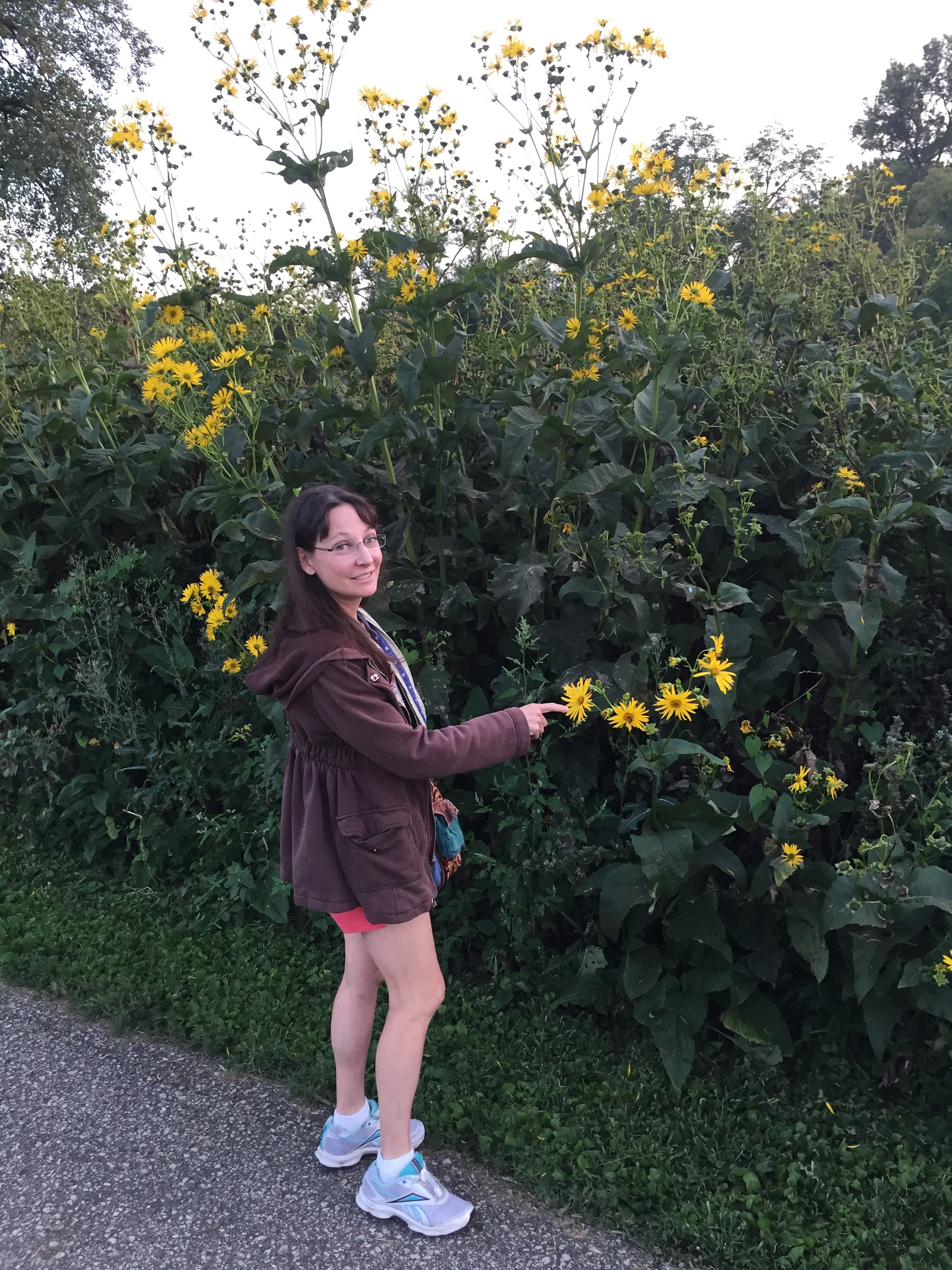
"And I have no idea what this is!" I am saying. Later on I learned it is cup plant, Silphium perforlatum.
With a quarter of a million plant species on Earth you are always a beginner.
It makes sense. McDonalds' yellow arches have replaced the square stem and opposite leaves motif of the very-recognizable mint family. The same pattern-recognizing-survival-based parts of our brains are engaged in decrypting the blue-and-red Pepsi Circle and the deadly white gills of Amanita mushrooms. The logo-recognizing function gets used more often than the nature-recognizing function, which is reinforcing.
There is hope. If kids are so good at recognizing detail, and they are, (consider the encyclopedic knowledge of dinosaurs residing in some) they will also delight in identifying plants and animals and fungi once they get a little basic training. Here are a few ways to support a foraging mindset, for kids and adults. Feel free to suggest more!
_____________
Plant awareness exercises
Find a docent-led walk in your area. I still go on these, and always learn something new, because there is always so much I don't know that I can learn from other plant lovers. I'll take my cell phone to take pictures, and a notepad for notes. If you have the time, it is far better to sketch a plant than to photograph it, for the sake of memorizing details, in your notes, regardless of your artistic ability.
Draw a plant
In my first botany class, I was horrified to be asked to draw the plants we were studying. I don't think of myself as a drawing sort of person. But
it turned out to be a fantastic exercise. If you really want to memorize a plant, don't photograph it. Draw it. Put to the side whatever thoughts you
have about your artistry. Take a plant, a pencil and paper, and draw exactly what you see.
It helps to learn some of the common variations of plant morphology first.
In drawing the plant, you have to ask yourself:
Do the leaf veins run parallel to each other or do they form a netted pattern?
Are the leaf margins serrated or smooth or scalloped?
Are the stems square or round or hollow?
Are the leaves alternating or directly opposing each other on a stem?
Are there hairs on the leaves or stem?
How many petals are there? Are they symmetrical?
Do the leaflets originate from one point (palmate) or along one rib (pinnate)?
Do flowers originate from one point (umbel) or along a stem (raceme) or appear singly on a stalk (simple)?
And so on.
Treasure hunts for kids
Depending on the age you are working with, you can teach kids to recognize not just plant parts (flowers, fruits, leaves, stem) but how they are arranged
(pinnate, palmate, monocot, dicot, raceme, corymb, umbel, etc.) Kids love pattern recognition and you can turn this exercise into a treasure hunt.
Find a palmate leaf!
Find a pinnate leaf!
Find a simple leaf!
Find an umbel flower!
Find a leaf with parallel veins!
Find a flower with four petals!
Here is a guide to classifying plant parts to give you more ideas.
Check out No Child Left Inside, which
is supported by a bipartisan congressional initiative.
_____
*It took me some work to find out where that claim, which is ricocheting about the internet, came from. I'd like to help shed
light on this for people like me that have been driven nuts trying to find the original reference. The memorable numbers 1000 and 10 probably first
arose from a chapter written by David W Orr, in Children and Nature: Psychological, Sociocultural, and Evolutionary Investigations,
which is a collection of articles by multiple authors including Orr.
Like the editors of this book, I don't like to make broad claims without backing them up with original research references.
Even if the intent is positive, the best intentions are weakened if the foundation of the claim rests on sloppy evidence.
And as I said above, I have been able to find a study with good evidence that preschoolers do recognize a great number of corporate logos, especially
ones related to products they for kids. Separate studies are able to show that yes, indeed, kids these days are terrible at recognizing plants
and animals.
Even a review of the book fails to mention that the editors themselves were bothered by Orr's claim and misleadingly attributes the claim to the editors. The editors still
wanted to include Orr's claim as they felt it an important idea to include. They write:
"Although Orr draws on research findings to argue his case, his characterizations of the problems should be read—in our view—as provocative hypotheses, not established facts. Of course we are aware that Orr himself would find this very caveat maddeningly conservative. He in effect asks in his chapter why we quibble about this fact or that fact when the overarching global problems are all too obvious."
News+Blogs Categories
Archive

